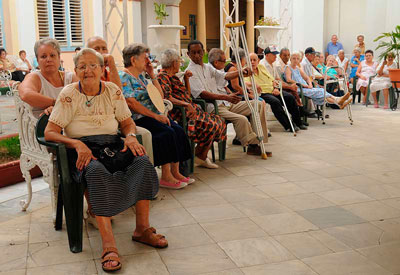Cuban Homes for the Elderly Maintained by Foreign Donations
Cuban Homes for the Elderly Maintained by Foreign Donations
By Daniel Benitez (Cafe Fuerte)

HAVANA TIMES — A total of 18 homes for the elderly in Cuba are operated by religious institutions and fraternal organizations, both of which are maintained by private donations and tax-payer’s money, in addition to the 12 million Cuban pesos (US $600,000) they receive from the State budget every year.
According to figures published by the Cuban press, of these homes, 12 are part of Catholic orders and congregations, 5 belong to Protestant churches and one to a Masonic lodge.
El reporte también aclara que solo 14 están registrados por el Departamento de Economía del Ministerio de Salud Pública (MINSAP).
The money destined to this type of social assistance by the State is the equivalent of one million Cuban pesos a month, divided amongst all of the country’s homes, that is to say, 55,555 pesos on average per home, or 1,851 pesos (US $ 92.50) a day. Dr. Alberto Fernandez, head of the Elderly Care Department of the Ministry of Public Health, explained that this money is used to buy food and medication and to pay the salaries of employees.
Propped up by Donations
Despite such low figures, the official insisted that the State budget represents an important part of the finances of these homes, which he refuses to regard as “private.” Though no exact definition of where these fall is offered, it is clear that third-party donations from abroad are what guarantee that hundreds of people continue to have beds and food every day of the year.
The case of the William Booth Home for the Elderly, located in Marianao, Havana, home to 34 people and operated by the Salvation Army Protestant church since 1944, is offered as an example of these institutions. This church operates another home in the province of Camaguey, with the cooperation of the Cuban Council of Churches, designed for people suffering alcoholism.
The church plans of setting up another home for the elderly in Santa Clara, the city with the highest aging index on the island, and a third one in Holguin.
Homes for the elderly operated by religious institutions and congregations represent a mere 12.5 percent of the total number of homes in the country. According to figures published by the National Statistics Bureau, there are currently 144 such homes in the country, 12 less than in 2008.
The number of beds available to elderly people in need of housing and food is indeed disquieting in a country with an aging population: a mere 9,598 in 2013, well below the 12,106 that existed in 2008.
A Very Serious Matter
The seriousness of the matter is driven home when we bear in mind that 18.3 percent of Cuba’s population is aged 60 or above. This is coupled with the deterioration of the nation’s housing infrastructure, the low pensions received by the elderly and the high average costs of food and other products in the country.
Faced with these circumstances, many feel they have made it to paradise when they are accepted at any of the 18 “private” homes, where food, supplies and even pocket money to buy cigarettes or coffee are made available to residents. In exchange, those admitted in these homes pay a percentage of their social assistance money, which, many a time, is less than 250 Cuban pesos (some US $ 12.50 a month).
For decades, the Cuban regime has boasted of its educational, health and social assistance systems before the world. The first two have been showing evident signs of decadence and deterioration, while the budget destined to social assistance has dwindled.
A study sponsored by CEPAL in 2012, titled Sistemas de Proteccion Social en America Latina y el Caribe: Cuba (“Social Assistance Systems in Latin America and the Caribbean: Cuba”), economist Carmelo Mesa Lago clearly showed that, while social spending represented 55.3 percent of the State budget in 2007, this figure dropped 2.2 percentage points in 2010.
Social Assistance Cutbacks
In November of 2013, Cuba’s official press acknowledged that the country’s homes for the elderly and asylums require “urgent changes” and that these fail to offer the 17,000 spots needed.
In addition, there are 230 “homes” that only care for the elderly during the day. These locales have capacity for 7,398 people, while the demand is for more than 20,000.
Social assistance has seen cutbacks as part of the adjustments made by Raul Castro’s government. In fact, according to official statistics, social security spending went down for the first time in decades under his administration, from 5,589 million pesos in 2014 to 5,564 million in 2015.
Homes for the elderly and locales where these people are cared for are constantly criticized by the population owing to the poor condition of the locales and the inadequate services offered there. Independent press sources have reported several deaths at these facilities (none operated by religious congregations or entities).
Homes for the elderly will inevitably grow in number in Cuba over the coming years owing to the country’s population aging, and those in the hands of private or semi-private institutions may become more common as the government proves increasingly incapable of guaranteeing coverage for those in need.






The human tragedy unspoken here is that the generation that gave the most to the Castro revolution is the generation which is suffering most for the lack of quality senior care and the generation most dependent on foreign charity instead of the revolutionary government they sacrificed so much to sustain.